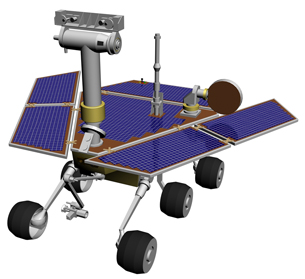Module 4—Gravitational Force
Lesson 3—Universal Gravitational Field Theory and the Density of Earth
 Get Focused
Get Focused

© Michael Ransburg/shutterstock
The Mars Rover was designed by NASA to explore the surface of Mars.
Earth has a mass of 5.9725 billion trillion tonnes. If scientists didn’t know this, they wouldn’t be able to explore the surface and geology of other planets, such as Mars. This should bring to mind two questions. First, how do scientists know how much mass Earth has (since it can’t be put onto a giant scale)? Second, how is that related to the development and deployment of rovers used to explore other planets, such as the rovers Spirit and Opportunity currently on Mars?
In the previous lesson you learned that a gravitational force is often referred to as a mass-attracting force. It is a force that exists between any two masses. The force can tell something about the masses causing it. But exactly how are the strength of a gravitational field and the mass creating it related? How could this relationship be investigated in a laboratory setting? Finally, how has this understanding led to the exploration of other planets and moons?
In this lesson you will explore the following questions:
- Is the force of gravity a constant?
- How do scientists calculate weight on other planetary objects, such as the Moon?
- How does the law of universal gravitation explain the motion of orbiting bodies?
- How can you calculate the mass of Earth?
Module 4: Lesson 3 Assignments
Your teacher-marked Module 4: Lesson 3 Assignment requires you to submit a response to the following:
- Try This—TR 1, TR 2, TR 3, and TR 4
- Reflect and Connect
You must decide what to do with the questions that are not marked by the teacher.
Remember that these questions provide you with the practice and feedback that you need to successfully complete this course. You should respond to all the questions and place those answers in your course folder.